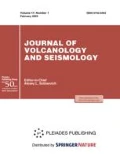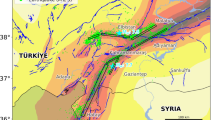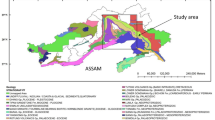Abstract
Previous publications by this author (Rodkin, 2008a, 2008b, 2012; Rodkin and Tikhonov, 2016; Rodkin and Rundkvist, 2017) proposed and actually used a method for constructing and analyzing the generalized vicinity of large earthquakes (GVLE). The GVLE method provides an enormous increase in the amount of data that is used and, hence, a much more detailed description of the typical features in the foreshock–aftershock process. The GVLE clearly detects the power-law foreshock seismicity increase and the aftershock process obeying the Omori–Utsu law. In addition, many parameters (the slope of the recurrence plot and the average depths of focus, apparent stresses, the duration of the seismic process, and several other quantities) show, when treated in the GVLE framework, similar anomalies whose amplitudes are increasing toward the time of the generalized large earthquake minus the logarithm of the time remaining until the occurrence. Similar anomalies (more frequently with different parameters) are observed both in the foreshock area and in the aftershock area. Because the anomalies are so similar we are entitled to treat them as a seismicity pattern. Precursory anomalies are of special interest. We discuss the question of which of these are primary and which are secondary. The anomaly is interpreted in terms of the multiplicative cascade model. An analogy in the character of this anomaly with Zhurkov’s concept of kinetic failure exists. We discuss the approaches to the use of the anomaly in earthquake prediction.








Similar content being viewed by others
REFERENCES
Aki, K., Maximum likelihood estimate of b in the formula logN = a – bM and its confidence limits, Bulletin Earthquake Research Institute University, Tokyo, 1965, no. 43, pp. 237–239.
Enescu, B., Mori, J., and Miyazawa, M., Kano Omori-Utsu Y. law c-values associated with recent moderate earthquakes in Japan, Bulletin of the Seismological Society of America, 2009, vol. 99, no. 2A, pp. 884–891.
Faenza, L., Hainzl, S., and Scherbaum, F., Statistical analysis of the central-Europe seismicity, Tectonophysics, 2009, vol. 470, pp. 195–204.
Helmstetter, A., Sornette, D., and Grasso, J.-R., Mainshocks are aftershocks of conditional foreshocks: how do foreshock statistical properties emerge from aftershock laws, J. Geophys. Res., 2003, vol. 108(B1), pp. 2046. https://doi.org/10.1029/2002JB001991
Lei Xinglin and Shegli Ma, Laboratory acoustic emission study for earthquake generation process, Earth Sci., 2014, vol. 27(6), pp. 627–646.
Molchan, G.M., Kronrod, T.L., and Nekrasova, A.K., Immediate foreshocks: time variation of the b-value, Physics of the Earth and Planetary Interiors, 1999, vol. 111, nos. 3–4, pp. 229–240.
Narteau, C., Shebalin, P., and Holschneider, M., Onset of the power law aftershock decay rate in Southern California, Geophysical Research Letters, 2005, vol. 32, L22312. https://doi.org/10.1029/2005GL023951
Ogata, Y., Utsu, T., and Katsura, K., Statistical features of foreshocks in comparison with other earthquake clusters, Geophys. J. Int., 1995, vol. 121, pp. 233–254.
Rodkin, M.V., Cumulative and multiplicative cascades as models for the classification and developing the mechanisms of natural disasters, Geoekologiya, 2001, no. 4, pp. 320–328.
Rodkin, M.V., On the regime of seismic activation in the generalized vicinity of large earthquakes, Fizicheskaya Mezomekhanika, 2008a, vol. 11, no. 1, pp. 74–79.
Rodkin, M.V., Seismicity in the generalized vicinity of large earthquakes, J. Volcanol. Seismol., 2008b, vol. 2, no. 6, pp. 435–445.
Rodkin, M.V., A model of seismicity as a set of avalanche-like relaxation episodes that occur on a set of metastable states, Fizika Zemli, 2011, no. 10, pp. 18–26.
Rodkin, M.V., Patterns of seismicity found in the generalized vicinity of a strong earthquake: Agreement with common scenarios of instability development, in Extreme Events and Natural Hazards, The Complexity Perspective, Geophys. Monogr. Ser., Sharma, A.S. and et al., Eds., AGU, Washington, D.C. 2012, vol. 196, pp. 27–39. https://doi.org/10.1029/2011GM001060
Rodkin, M.V. and Rundkvist, D.V., Geoflyuidodinamika. Prilozhenie k seismologii, tektonike, protsessam rudo- i neftegeneza (Geofluid Dynamics. Application to Seismology, Tectonics, Mineralization and Oil generation Processes), Dolgoprudnyi: Intellekt, 2017.
Rodkin, M.V. and Tikhonov, I.N., The new avalanche-like stochastic model for parameterization of seismicity and its application to the south Sakhalin Island seismicity, International Journal of Geophysics, 2012, vol. 2012, Article ID 364318. 12 p. https://doi.org/10.1155/2012/364318
Rodkin, M.V. and Tikhonov, I.N., The typical seismic behavior in the vicinity of a large earthquake, Physics and Chemistry of the Earth, 2016, vol. 95, pp. 73–84.
Rodkin, M.V., Gvishiani, A.D., and Labuntsova, L.M., Models of generation of power laws of distribution in the processes of seismicity and in formation of oil fields and ore deposits, Russian J. Earth Sciences, 2008, vol. 10, no. 5, pp. 47–54.
Rodkin, M.V., Ngo Thi Ly, and Labuntsova, L.M., Expanding the multiplicative cascade model to describe the recurrence of great earthquakes in application to the seismicity of Southeast Asia, Geofizicheskie Issledovaniya, 2015, vol. 16, no. 2, pp. 59–69.
Romashkova, L.L. and Kosobokov, V.G., The dynamics of seismic activity before and after great earthquakes worldwide, 1985–2000, Vychislitelnaya Seismologiya, 2001, vol. 32, pp. 162–189.
Sadovsky, M.A., Bolkhovitinov, L.G., and Pisarenko, V.F., On discreteness in rocks, Izv. AN SSSR, Fizika Zemli, 1982, no. 12, pp. 3–19.
Shebalin, P. and Baranov, S., Long-delayed aftershocks in New Zealand and the 2016 M 7.8 Kaikoura earthquake, Pure Appl. Geophys., 2017, vol. 174, no. 7, pp. 2645–2659. https://doi.org/10.1007/s00024-017-1608-9
Shebalin, P. and Narteau, C., Depth dependent stress revealed by aftershocks, Nature Communications, 2017, vol. 8, pp. 1317. https://doi.org/10.1038/s41467-017-01446-y
Sherman, S.I., Rodkin, M.V., and Gorbunova, E.A., A tectonophysical analysis of earthquake frequency–size relationship types for catastrophic earthquakes in Central Asia, J. Volcanol. Seismol., 2017, vol. 11, no. 6, pp. 434–446.
Smirnov, V.B. and Ponomarev, A.V., Patterns in the relaxation of seismicity from field and laboratory observations, Fizika Zemli, 2004, no. 10, pp. 26–36.
Smirnov, V.B., Ponomarev, A.V., Bernar, P., and Patonin, A.V., Patterns in the transient regimes of seismicity based on laboratory and field modeling, Fizika Zemli, 2010, no. 2, pp. 17–49.
Smirnov, V.B., Ponomarev, A.V., Stanchits, S.A., et al., A laboratory modeling of aftershock sequences: The parameters in the Omori law and in the Gutenberg–Richter relation as functions of stress, Fizika Zemli, 2019, no. 1, pp. 149–165.
Sobolev, G.A., Osnovy prognoza zemletryasenii (Principles of Earthquake Prediction), Moscow: Nauka, 1993.
Wells, D.L. and Coppersmith, K.J., New empirical relationships among magnitude, rupture length, rupture width, rupture area, and surface displacement, BSSA, 1994, vol. 84(4), pp. 974–1002.
Zhurkov, S.N., Kinetic concept of the strength of solids, Int. J. Fract. Mech., 1965, vol. 1, pp. 311–323.
Zhurkov, S.N., A kinetic concept of the strength of solids, Vestnik AN SSSR, 1968, no. 3, pp. 46–52.
Funding
This work was supported in part by the Russian Foundation for Basic Research, project no. 19-05-00466.
Author information
Authors and Affiliations
Corresponding author
Additional information
Translated by A. Petrosyan
Rights and permissions
About this article
Cite this article
Rodkin, M.B. A Typical Foreshock and Aftershock Anomaly: Observations, Interpretation, and Applications. J. Volcanolog. Seismol. 14, 58–69 (2020). https://doi.org/10.1134/S0742046320010066
Received:
Revised:
Accepted:
Published:
Issue Date:
DOI: https://doi.org/10.1134/S0742046320010066




